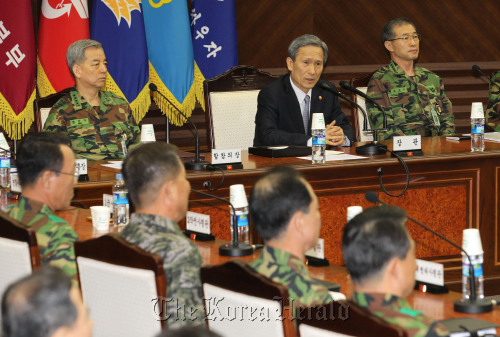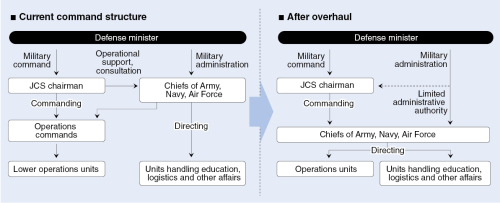Some retired generals doubt whether reform measures will be effective
The Ministry of National Defense is pushing ahead with a major military overhaul, aiming to make its bloated command apparatus “strong, speedy and slim” and ready itself to take back wartime operational control from the U.S. in 2015.
The envisioned large-scale reform comes as the military is toiling to address a series of shortcomings revealed in the wake of the two deadly North Korean attacks last year that killed 50 South Koreans.
“The reform is aimed at enhancing our readiness posture and will be carried out in line with our preparations for the OPCON transfer, after which our military will independently plan, organize and lead wartime operations with the U.S. playing a supporting role,” a senior MND official told reporters, declining to be named.
“The top command structure will be streamlined in a way that enhances efficiency and ‘jointness’ while weak subordinate units will be strengthened with a better personnel management scheme.”
Although they agree on the need for military reform, some retired general-grade officers, particularly those who served in the Navy and Air Force, have raised doubts over whether the measures could effectively resolve the pending military issues.
The centerpiece of the reform is the reorganization of the top command structure aimed at strengthening the role of the Joint Chiefs of Staff chairman, who will serve as the commander for wartime theater operations on the peninsula.
Under the reform plans, the ministry seeks to put four-star chiefs of the Army, Navy and Air Force under the operational control of the JCS chairman by November 2012 so that they can command military operations of their own specialty.
Under the current structure, they only have the authority to lead personnel management, education, logistical support and other administrative affairs. They do not have authority to direct military operations.
Under the current structure, the JCS chief gives operational directives to three-star chiefs of operations commands when there are ground, naval and aerial operations.
The ministry expects the new authority for the chiefs of the three military wings to enhance peacetime and wartime operations as they would be deeply involved in the operations with their knowledge and experience.
“With the authority, the chiefs of the Navy and Air Force will direct and lead their units in naval and aerial operations. Based on their deep expertise, the operations will be carried out more effectively and successfully,” the official said.
The Ministry of National Defense is pushing ahead with a major military overhaul, aiming to make its bloated command apparatus “strong, speedy and slim” and ready itself to take back wartime operational control from the U.S. in 2015.
The envisioned large-scale reform comes as the military is toiling to address a series of shortcomings revealed in the wake of the two deadly North Korean attacks last year that killed 50 South Koreans.
“The reform is aimed at enhancing our readiness posture and will be carried out in line with our preparations for the OPCON transfer, after which our military will independently plan, organize and lead wartime operations with the U.S. playing a supporting role,” a senior MND official told reporters, declining to be named.
“The top command structure will be streamlined in a way that enhances efficiency and ‘jointness’ while weak subordinate units will be strengthened with a better personnel management scheme.”
Although they agree on the need for military reform, some retired general-grade officers, particularly those who served in the Navy and Air Force, have raised doubts over whether the measures could effectively resolve the pending military issues.
The centerpiece of the reform is the reorganization of the top command structure aimed at strengthening the role of the Joint Chiefs of Staff chairman, who will serve as the commander for wartime theater operations on the peninsula.
Under the reform plans, the ministry seeks to put four-star chiefs of the Army, Navy and Air Force under the operational control of the JCS chairman by November 2012 so that they can command military operations of their own specialty.
Under the current structure, they only have the authority to lead personnel management, education, logistical support and other administrative affairs. They do not have authority to direct military operations.
Under the current structure, the JCS chief gives operational directives to three-star chiefs of operations commands when there are ground, naval and aerial operations.
The ministry expects the new authority for the chiefs of the three military wings to enhance peacetime and wartime operations as they would be deeply involved in the operations with their knowledge and experience.
“With the authority, the chiefs of the Navy and Air Force will direct and lead their units in naval and aerial operations. Based on their deep expertise, the operations will be carried out more effectively and successfully,” the official said.

To support the role of the theater operations commander, the new measures will also give the JCS chief “limited” authority for military administration, which critics argue will give “excessive privileges” to him.
The JCS chief does not currently have any authority concerning personnel management, logistics and other administrative affairs.
The new authority involves four rights to “recommend” his JCS staff for promotion or troop assignments, or to reprimand his staff for operations-related faults; demand logistical support; control education on joint operations; and request troop mobilization.
Critics express concern that with what they call the “inordinate” authority, the JCS chief, who has always been an Army general except for one case, could hold sway over all the other military branches and hamper jointness among them.
But the ministry says the authority is only “limited” and that chiefs of the three armed services will lead major administrative affairs as they have been.
Under the reform plans, the JCS will also face structural changes.
Under the JCS chairman, there will be two vice JCS chairmen ― one four-star general-grade officer in charge of the operational command and one three-star general leading the operational support.
The four-star vice chief, who will play a role as commander of a joint military command, will serve as counterpart to the chief of the U.S. Korea Command.
The U.S. KORCOM is a new headquarters for the U.S. troops here, which will be established in Korea as South Korea seeks to take over the war-fighting capabilities of the South Korea-U.S. Combined Forces Command.
As part of efforts to improve the command structure, the reform plans also seek to merge the headquarters of the three armed services and operations commands by December 2014.

The Army will consolidate its headquarters, and First and Third Army Commands. But its 2nd Operations Command will remain as it is and will lead operations to protect non-frontline areas during peacetime and support the missions of the U.S. troops to be dispatched to the peninsula during wartime.
The envisioned merger of the major units will lead to the integration of the military administration and command, which will enhance efficiency and reduce overlapping functions and unnecessary staffers, officials said.
The Army, Navy and Air Force will then have two vice chiefs ― one in charge of the military command and the other in charge of administration and other operational support. The vice chiefs will be three-star officers except one four-star vice Army chief.
Through the reorganization of the command structure, the ministry estimates positions of some 30 general-level officers including one four-star general will be removed by 2015. The merger of the military units will remove another 30 general-grade officers around by 2020, officials said.
The envisioned overhaul will also affect the command structure of the South Korea-U.S. combined forces during wartime.
For wartime operations, the South Korean JCS chief will lead the combined Army and Navy troops. But the combined Air Force will be led by the commander of the U.S. Seventh Air Force as the U.S. will mobilize its massive aerial assets during wartime.
The South Korean vice Air Force chief will serve as a vice commander of the combined Air Force while the Air Force chief will offer operational support.
By Song Sang-ho (sshluck@heraldcorp.com)


















![[Today’s K-pop] Treasure to publish magazine for debut anniversary](http://res.heraldm.com/phpwas/restmb_idxmake.php?idx=642&simg=/content/image/2024/07/26/20240726050551_0.jpg&u=)